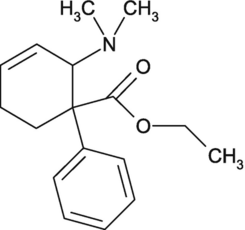Tilidine

Fatal overdose may occur when opiates are combined with other depressants such as benzodiazepines, barbiturates, gabapentinoids, thienodiazepines, alcohol or other GABAergic substances.[1]
It is strongly discouraged to combine these substances, particularly in common to heavy doses.
| Tilidine | |||||||||||||||||||||||||||||||
|---|---|---|---|---|---|---|---|---|---|---|---|---|---|---|---|---|---|---|---|---|---|---|---|---|---|---|---|---|---|---|---|
 |
|||||||||||||||||||||||||||||||
| Chemical Nomenclature | |||||||||||||||||||||||||||||||
| Common names | Tilidine, Tilidin, Darby, Valoron, Generika | ||||||||||||||||||||||||||||||
| Substitutive name | Tilidine | ||||||||||||||||||||||||||||||
| Systematic name | (E)-2-(Dimethylamino)- 1-phenyl-cyclohex-3-en- 1-carbonsäureethylester | ||||||||||||||||||||||||||||||
| Class Membership | |||||||||||||||||||||||||||||||
| Psychoactive class | Opioid | ||||||||||||||||||||||||||||||
| Chemical class | Opioid | ||||||||||||||||||||||||||||||
| Routes of Administration | |||||||||||||||||||||||||||||||
|
|||||||||||||||||||||||||||||||
| Interactions | |||||||||||||||||||||||||||||||
Tilidine (also known as Ethyl-6-(dimethylamino)-3,6-dihydro-[1,1`-biphenyl]-1(2H)-carboxylat) is a synthetic opioid
Tilidine is an opioid pain medication used to relieve moderate to severe pain. It's often combined with naloxone to reduce the risk of misuse. As with any opioid, it should only be used under the supervision of a healthcare professional and as prescribed, as it can be habit-forming and has potential side effects.
Dangerous interactions
Warning: Many psychoactive substances that are reasonably safe to use on their own can suddenly become dangerous and even life-threatening when combined with certain other substances. The following list provides some known dangerous interactions (although it is not guaranteed to include all of them).
Always conduct independent research (e.g. Google, DuckDuckGo, PubMed) to ensure that a combination of two or more substances is safe to consume. Some of the listed interactions have been sourced from TripSit.
- Alcohol - there is a mutual amplification and prolongation of the depressant effect on the central nervous system. These combinations can have such a strong respiratory depressant effect.
- Benzodiazepines - May lead to an increase in respiratory depressant effects and increase the risk of respiratory failure.
- Cocaine - May lead to increased stress on the cardiovascular system and increase the risk of heart problems.
Legal status
- USA* Tilidine is not available as an approved drug in the U.S. </ref>
- Europe* In the EU Tilidine is prescribed for severe pain </ref>